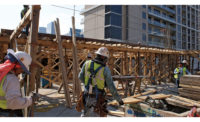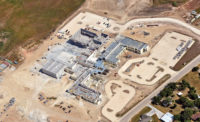"Energy efficiency and data centers don't always go hand in hand, but we're really targeting the heat-generating equipment rather than just cooling a big room," Reagan says.
'We're In The Parking Lot'
Taking the existing fire station and city hall, once two separate structures, and turning them into one data center has generated many building revamps over the years. Those buildings were repurposed and reconnected for multiple departments, Razinha says.
Part of that mish-mashed approach meant cooling and generation systems were essentially "slapped together" over the years whenever more of either was needed, he adds.
"So we're going to get healthier off this [renovation and expansion] as well because we designed a smart package for energy efficiency as well as something that was specifically for a data center; before, we just had a room and stuck some servers in it," Razinha notes. "Now we're going to have a dedicated data center component of the IT facility with the goal when we designed it for future growth."
Crawford emphasizes that this renovation is also taking place in an extremely congested site—"literally we're in the parking lot for Plano's city hall," he says.
"We've also got multifamily housing right across the street and we're in downtown Plano, Texas, so there are restaurants and shops and things like that," Reagan points out. "That means ancillary traffic around the building, so it's what I would consider a fairly dangerous site—not from a health standpoint, but just because so it is so site constrained."
Noise ordinances added to the mix, limiting the start and end time for the contractor.
Using 3D modeling software, Turner decided to show city officials what exactly would take place over the next several months of construction, such as areas of the facility that would be impacted or impeded, to make sure the construction process didn't affect any of the city's ongoing operations.
"We also utilized [building information modeling] as the project has progressed," Crawford says. "Noting the building's extensive chilled-water piping infrastructure and mechanical plumbing "we've modeled through BIM several of the key components, which has allowed us to prefabricate pretty much all the chilled-water piping associated with the project."
According to Turner, the team used prefabrication for 100% of the chilled-water steel pipe, and in most other parts of the chilled-water system and duct work.
Bringing in these prefabricated materials also required careful coordination on site, where the space was extremely limited. So the team turned to just-in-time deliveries for all duct work and MEP equipment to keep the workflow going. All delivered equipment and materials have been installed within a day of arriving on site, Crawford says.
He notes use of lean construction approaches "so that our milestones for each phase of the project are hit as needed."
Growth, Communication
Data-center upgrades have been a growth market for Turner and others. Within just the past five years, the firm says it has delivered more than $2 billion in data-center and control-room projects in Texas, which includes more than 30 mission-critical projects.
"One of the challenges earlier on was just coming to a consensus and looking as far forward as we could in terms of what the city was going to need for a data center, so we spent a good bit of time touring other data centers," says Reagan.
"The city could then make a reasonable and informed decision on how big the data center needs to be for expansion so they're not having to do this again in 15 or 20 years," he adds.







